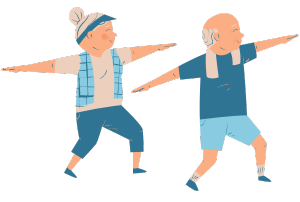Falls are a leading cause of injury-related deaths for older adults, and pose an even greater risk for people with a neurodegenerative disease such as Alzheimer’s. People with Alzheimer’s are up to 8 times more likely to fall because of difficulties with mobility, strength and balance. Balance problems are more common in the later stages of the disease, emphasizing the need to take preventative steps early.
Let’s take a closer look at how Alzheimer’s affects balance.
Balance is the integration and coordination of sensory, cognitive and motor processes. We take in information about the world around us and our body position in relation to the world around us. Numerous systems collaborate, including the visual, vestibular, and sensory-motor systems, working in tandem to receive and process this information. Subsequently, the brain translates these perceptions and relays commands that guide our actions. Neurodegenerative disease affects these processes and can result in difficulties with vision, information processing and movement coordination. Some types of neurodegenerative diseases affect an area in the brain called the cerebellum. Located at the back of your head, the cerebellum is involved in controlling body movement. When the cerebellum is affected by a disease, poor movement coordination and control can result, in increasing fall risk. People may walk with an uneven stride or even shuffle their feet and can have more difficulty walking in a straight line.
Alzheimer’s also leads to muscle weakness and muscle atrophy. People tend to become less physically active due to the increased challenges of physical movement, decreased motivation and decline in physical function. As muscles weaken, people lose their ability to prevent or control falls due to a lack of strength and coordination.
It is important to take action early to reduce the decline in balance. The best way to improve your balance is simply by practicing balancing! One of the most simple ways to practice balance is to choose a challenging stance and try holding it for a period of time. Here are some examples of balance stances:
- Rhomberg: Stand with your feet together, narrowing your base of support
- Tandem: Stand with one foot directly in front of the other, your toes touching the heel of your other foot
- Single leg: Stand on one leg with the other leg elevated in front of you, not touching your other leg
- Tandem walk: Practice walking heel-to-toe in a straight line
With these balance stances, you want to make sure you are challenging all of the systems utilized in balance by altering your information input. Try closing your eyes, standing on an uneven surface or moving your head back and forth as you balance. Another option is to participate in an activity that challenges balance. Tai Chi, Qi Gong and yoga are some examples. Going for slow, deliberate walks on uneven ground will also challenge your balance.
Whether you are working with a neurodegenerative disease or not, balance is important for all activities! Although it is ideal to start working on it early and maintain your skills, it is never too late to start working on improving your balance.
Contact our Athletic Therapist, Crystal, today and she can assess your balance and come up with a plan to help you improve and maintain your balance abilities!
Crystal Bartkowski,
Certified Athletic Therapist

